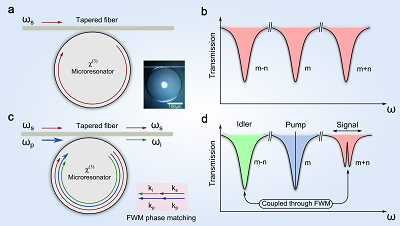
Time:2016-05-19 Read:10788
Electromagnetically induced transparency (EIT) is one of the greatest discoveries to verify the quantum interference nature of atomic systems. It allows the flipping of an optical opaque transmission window to a transparent one under a secondary coherent illumination beam, which immediately provides an opportunity for light–matter–light interactions that are in great demand by all-optical and quantum information processing. EIT was first proposed and observed in atomic gases, and has also been observed in solid state systems. Much attention has been drawn to its unique properties, including slowing or even stopping light, all optical switching and photon storage. This provides tremendous opportunities for quantum physics and information science. However, in most circumstances, those atoms must be prepared in gas phase, which requires optical cooling or vapor heating techniques combined with vacuum isolation, making it difficult for chip-scale integrations, which are the major proposed applications.
Alternatively, classical analogies that mimic the EIT effect are under active pursuit in various physical systems, including coupled resonators, photonic crystals and plasmonic meta-materials. In recent years, there has been an increasing interest in the implementations of the effect in optical microcavities due to their flexibility, tunability, engineerability and on-chip compatibility. The novel effect has been enforced in types of geometries, such as coupled microresonators, coated microresonators and single microresonator. In all of these implementations, two frequency overlapped WGMs either of single or two separate optical microcavities are coupled, and destructive interference of the optical pathways cancels the absorption leading to a narrow peak in the transmission spectra. Since resonant frequencies of a high-Q microresonator are highly sensitive, finding two WGMs close enough in frequency and controlling the coupling of them imposes considerable difficulty. These two conditions require accurate design, precise fabrication and sophisticated tuning, which hinder various practical applications. So far, most of these rely on linear coupling between the resonances, which can only exhibit EIT-like spectra, but lack of actively controlled transparency.

We reported an optically induced transparency (OIT) scheme in a compact micro-cavity in an ambient environment by exploring cavity enhanced four-wave mixing (FWM) gain to introduce a transparency window in an opaque resonance dip. This resonance dip directly results from the interference between two resonances (Signal and Idler, spacing by multiple FSRs) that are coupled nonlinearly through the FWM process. Active controlling of the OIT can be achieved by varying a strong pump beam. The advantage of the scheme is that the OIT effect can be induced at desired wavelengths, which is critical for practical applications.
The active all-optical controlling of the OIT is one more advantage over conventional EIT or EIT-like effect in coupled resonators. The effect can be turned on/off by switching the optical pump. Furthermore, the OIT observed is a non-reciprocal one, like an optical diode, because the FWM gain is unidirectional owing to the conservation law of momentum. The unique OIT scheme offers a completely new platform to study analogical atomic quantum interference effects in a simple manner. Moreover, it can be further exploited for critical on-chip photonics applications, such as optical isolator, all-optical switching and wavelength conversion.
See also: Light: Science & Applications, 5, e16072 (2016)
Link: http://www.nature.com/lsa/journal/v5/n5/abs/lsa201672a.html